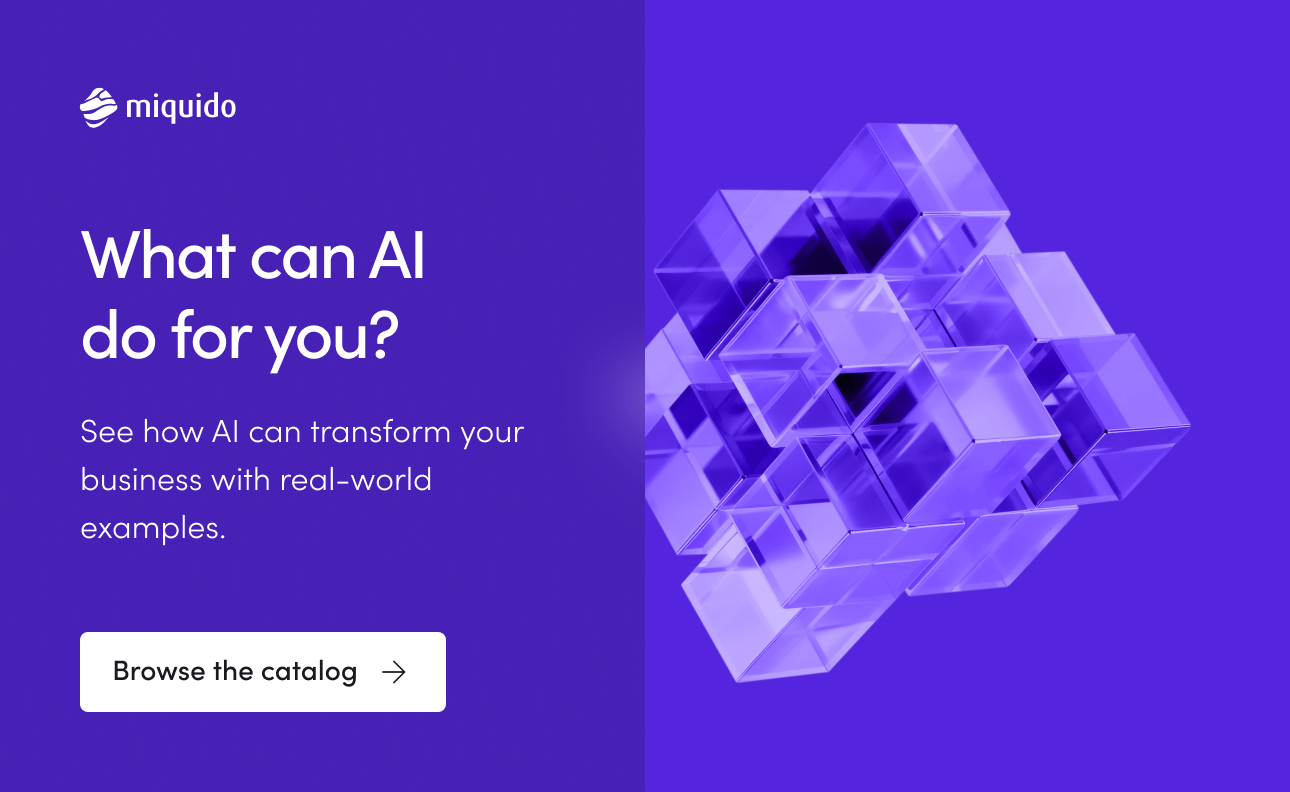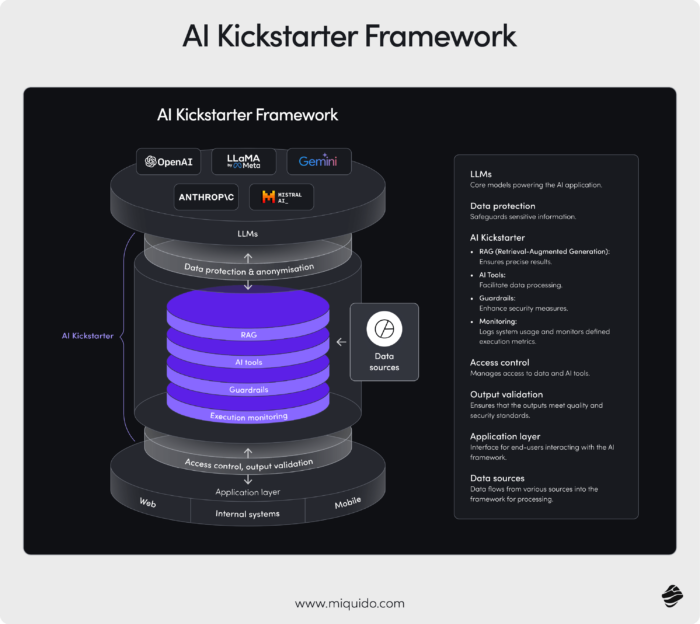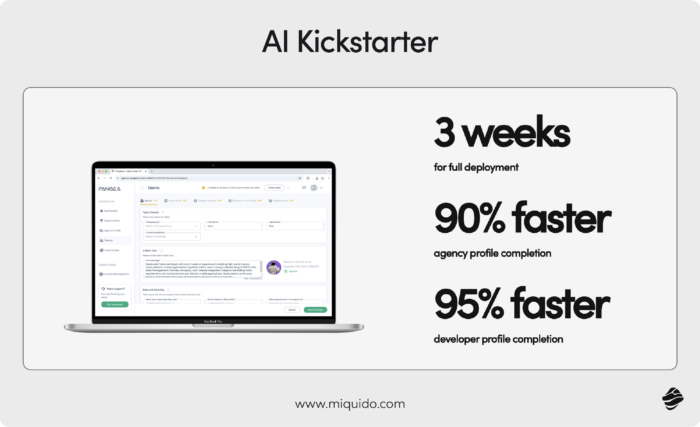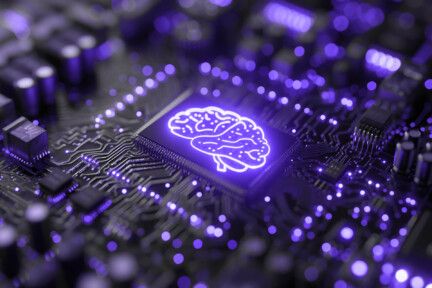AI industry predictions for 2025 point to a pivotal moment as the technology moves from innovation to implementation at scale. Businesses are no longer asking if they should adopt artificial intelligence but how they can integrate it effectively to stay competitive.
If you’re tracking business adoption rates or exploring the role of regulations, this article is for you. You’ll gain a clear glimpse into the future of AI and its transformative potential across industries worldwide.
AI adoption rates are soaring
AI implementation is reaching unprecedented levels, with enterprise adoption predicted to surpass 70% by 2025, according to Forrester. This means businesses are no longer testing the waters. They’re diving in headfirst, using AI to boost productivity, streamline operations, and enhance decision-making processes.
The economic implications are staggering.
Deloitte estimates AI will add $15.7 trillion to the global economy by 2030, with a substantial acceleration starting in 2025. This growth comes from industries embedding AI into their operations. Tasks like forecasting, data analysis, and customer support are becoming faster, more accurate, and highly scalable.
AI agents take center stage
AI agents are shaping up to be one of the biggest trends in AI predictions for 2025. These bots are designed to work independently. They can set goals, make decisions, and handle multiple tasks at once without needing constant input from humans.
Soon, AI agents will become smarter, more reliable, and widely used to help businesses work more efficiently and make better decisions. Tools like AutoGPT and Microsoft’s AutoGen already show how they can manage projects, analyze data, and improve customer interactions.
That said, not everything labeled an “AI agent” is the real deal. Many companies use the term for systems that are essentially customized versions of Large Language Models (LLMs). While these are still useful, they don’t match the autonomy or multitasking power of true AI agents.
Startups like Wordware are pushing the boundaries with conversational AI agents tailored to specific business needs. Their agents are helping companies improve customer service, automate workflows, and handle complex tasks with minimal oversight.

Multimodal models are game-changers
Multimodal AI is a technology that can process text, images, and audio together, creating more interactive and versatile applications. This trend has been advancing with models like Claude 3, GPT-4o, and Gemini 1.5.
For instance, multiple models can analyze a photo, summarize accompanying text, and even provide audio feedback, all within a single interface.

This is particularly useful for applications in education, design, and accessibility, where users can benefit from richer and more engaging experiences.
Also, Apple’s rumored MM1 model is expected to shake up the competition with its privacy-first approach. Unlike other models that rely on cloud processing, MM1 could set a new standard by prioritizing user data security while delivering high-performance multimodal capabilities.
RAG is transforming retrieval systems
Retrieval-augmented generation (RAG) is a technique for handling vast amounts of data. It combines the generative capabilities of AI models with the ability to pull real-time information from external sources.
RAG is especially predicted to influence industries that rely on accurate, up-to-date insights in 2025.
For example, traditional AI models might generate responses based solely on their training data, which can become outdated. RAG, on the other hand, retrieves relevant information from live datasets or knowledge bases, ensuring outputs are both current and contextually accurate.
Popular frameworks like Amazon Bedrock and NVIDIA’s RAG tools make it easier for enterprises to adopt this technology. These solutions help businesses seamlessly integrate RAG into workflows to support real-time insights for tasks like trend analysis, report generation, and customer interactions.
For companies unsure how to start, Miquido’s AI Kickstarter program offers tailored guidance on leveraging technologies like RAG. This program is designed to help businesses identify their needs and prototype solutions.

It also supports the successful integration of AI-powered tools, unlocking the full potential of innovations like RAG.
GenAI expands beyond text
Custom generative AI solutions are no longer confined to text. It’s venturing into new, exciting territory with video production.
Tools like HeyGen, Sora, and Runway ML already support the creation of realistic and personalized video content. Businesses and creators can produce high-quality videos without expensive equipment or large production teams.
Over the next year, gen AI is expected to revolutionize marketing by enabling tailored videos that address customers by name, creating highly personalized experiences.
In education, gen AI will deliver personalized learning materials that adapt to each student’s pace. The lessons will become more engaging and effective for diverse learners.
Generative AI tools democratize video production, allowing smaller businesses and individual creators to compete with major studios. As businesses start to see beyond generative AI risks, we can expect videos to become even more dynamic, interactive, and lifelike.
Local models for sensitive industries
Unlike cloud-based AI, local models keep data within an organization’s own systems as opposed to third-party data centers. This minimizes risks of breaches or regulatory issues. In 2025, this will make them a top choice for industries with strict security and compliance requirements, bringing locally deployable models and edge computing into focus.
Models like Llama 1B and 3B have been recognized for their ability to operate securely on-premises. They are ideal for sensitive sectors such as banking, healthcare, and fintech.
For example, a hospital using a local AI model can analyze patient data securely on-site. So, while leveraging AI’s powerful insights, it also ensures compliance with privacy laws like HIPAA.
This shift is significant in banking and finance, where trust and security are critical. With locally deployable models, financial institutions can implement fraud detection, risk analysis, and personalized services without exposing sensitive customer information to external servers.
AI regulations shape the future
Governments worldwide are taking action to ensure top AI features are developed and used responsibly. By 2025, new regulations will define how AI systems operate, prioritizing user protection, ethical practices, and transparency. These standards aim to enhance trust and ensure that AI serves society effectively and safely.
The EU AI Act is a standout example. It classifies AI applications by risk level. High-risk uses, such as facial recognition or healthcare diagnostics, will face stricter requirements to guarantee safety and fairness. The act also emphasizes transparency to ensure people know when they are interacting with AI.
In the US, the executive order prioritizes innovation and security. It seeks to prevent bias, enhance accountability, and promote ethical practices while encouraging progress.
Similarly, Australia is shaping its own AI governance approach, with frameworks aimed at safeguarding users and balancing innovation with responsibility.
Enhanced security is a priority
Security has taken center stage as AI becomes more integral to business operations.
As per 2025 predictions, dev teams are ramping up efforts to protect their AI models from vulnerabilities, with “AI Red Teaming” emerging as a critical practice.
AI red teaming involves specialized groups tasked with probing AI systems for weaknesses. These teams simulate adversarial attacks, testing the limits of an AI model’s robustness, reliability, and security.
For instance, they might introduce misleading data to see if the system makes inaccurate predictions or exploits weak points in an AI-driven decision-making process.
This proactive approach helps organizations identify and address potential flaws before malicious actors can exploit them. It’s especially important in industries like finance, healthcare, and autonomous systems, where even small errors can have serious consequences.
Secure AI Frameworks (SAIF)
As AI continues to evolve, so do the threats it faces. To address these challenges, companies like Google have developed Secure AI Frameworks (SAIF) designed to protect AI technologies against adversarial attacks and ensure their reliability.
SAIF frameworks are essentially a set of best practices, tools, and protocols aimed at building more resilient AI systems. They tackle vulnerabilities by focusing on areas like robust model training, adversarial testing, and continuous monitoring.
For instance, a system trained with a SAIF-compliant approach is better equipped to handle manipulated inputs intended to deceive or disrupt its performance.
These frameworks are valuable in high-stakes environments, such as healthcare and autonomous driving, where the margin for error is razor-thin.
2025 AI predictions indicate that Secure AI Frameworks are expected to become standard practice. They will help proactively address risks and ensure that AI investments are safe and trustworthy.
Third-party guardrails are gaining popularity
AI safety means designing secure systems. But it also involves adding external protections.
Tools like Guardrails AI are becoming essential, allowing vendors to embed safety checks directly into their AI workflows. These guardrails act as a layer of protection, monitoring AI behavior to ensure outputs meet ethical and business standards.
For example, they can identify and flag biased or inappropriate responses, helping an AI development team maintain reliability and fairness in their applications. They’re also helpful for enforcing compliance with industry regulations and reducing risks when deploying AI at scale.
Guardrails AI is especially valuable for companies using LLMs or generative AI, where unpredictability can be a challenge. Adding these third-party safeguards ensures businesses can stay in control of their AI systems, even as the technology gets more complex.
Model evaluation gains importance
As competition in AI intensifies, thorough model evaluation is becoming essential for development. By 2025, businesses will focus more on testing and assessing their AI revolution apps to ensure they are secure, reliable, and effective.
Model evaluation goes beyond basic functionality checks. It involves stress-testing systems under different conditions. This includes assessing:
- Performance with unseen data
- Handling of edge cases
- Resilience against adversarial attacks designed to manipulate outputs.
Many sectors require AI systems that deliver consistent and accurate results in critical, high-stakes scenarios. Competitive pressures are pushing companies to meet these standards, making robust evaluation a key differentiator in the market.
The growing availability of third-party benchmarking tools and certifications is further driving this trend. These tools allow AI companies to demonstrate the security and effectiveness of their AI solutions. Ultimately, they will help to build trust with users, stakeholders, and regulators.
The business perspective: bridging hesitation and impact
AI adoption is surging, but not without hesitation. While its potential is clear, many CEOs remain cautious, seeing artificial intelligence as either too immature or risky for critical, customer-facing roles.
Some businesses are hesitant to invest fully in AI because of concerns about reliability, implementation costs, and a lack of clear ROI.
However, these concerns are often outweighed by real-world results. Successful projects across industries show that AI is viable and transformative. When businesses focus on clear goals and plan effectively, the AI app development cost becomes an investment that drives measurable ROI.
1. Proven projects in AI implementation
At Miquido, we’ve implemented over 20 successful generative AI projects across various industries and use cases.
For Huuuge Games, we developed an AI-powered chatbot to streamline internal operations. The chatbot automated repetitive tasks, reducing the workload for team members and improving overall efficiency. This smart assistant saved significant time, allowing the team to focus on higher-value activities.
For Pangea, we built an AI-powered document information extraction tool leveraging RAG to handle complex datasets. The system automated the extraction and organization of key information from unstructured documents. It drastically improved data processing speed and accuracy.

All of our generative AI use cases are great examples of how AI can transform workflows. The applications we developed enabled smarter decision-making, delivered clear AI ROI, and unlocked measurable business value.
2. Impact across industries
AI is making waves across industries, delivering measurable results that go beyond mere experimentation. In healthcare, AI-driven diagnostic tools are revolutionizing patient care. AI analyzes medical images, lab results, and patient histories. AI-driven diagnostics are reducing error rates by a whopping 20-30%.
In the banking sector, AI-powered fraud detection is significantly cutting financial losses. Algorithms capable of identifying suspicious transactions and patterns in real time have reduced fraud-related losses by up to 40%. Financial institutions can protect themselves and their customers more effectively.
Retail is another standout example of how AI is enhancing customer experiences through advanced personalization engines. These systems analyze shopping behaviors, preferences, and trends to deliver tailored product recommendations.
The result? A boost in customer engagement and sales, often by 25% or more, which proves the value of a personalized shopping experience powered by AI.
3. Advisory and technology gaps
As more companies adopt AI, a divide is becoming clear: some focus on guiding businesses through the process, while others are busy building the technology. Consulting companies offer to plan strategies and implement AI solutions while tech experts work on creating smarter, more advanced systems.
However, many business leaders struggle to see how AI fits their specific needs. They understand its potential but often lack clarity on practical use cases or measurable outcomes for their industries. This uncertainty leads to hesitation, as companies aren’t sure where to start or how to evaluate success.
To close this gap, businesses need more than tools. They need tailored solutions. Clear examples, relevant case studies, and industry-specific applications can show how AI solves real challenges. With these in hand, the tech industry can help companies confidently adopt AI and unlock its full potential.
4. A call to action for enterprises
AI is ready now. It’s a mature and accessible tool that is already transforming industries today. Companies that delay adoption risk being outpaced by those leveraging AI to enhance efficiency, decision-making, and customer experiences.
Rather than aiming for large-scale implementations immediately, businesses can start with small, focused pilot projects.
Starting small allows you to test AI’s potential in low-risk scenarios, measure its impact, and learn from early experiences. This could be automating a single workflow or enhancing a specific customer interaction. Small steps build confidence and provide a foundation for scaling successful solutions.
2025: The year of pragmatic AI
Given the rapid pace of AI advancements, 2025 will mark a turning point defined by practical innovations and widespread adoption across industries. This is the year when AI leaders and their applications stop being seen as experimental and become pragmatic, indispensable tools across industries.
One of the key AI trends in mobile apps will be the creation of more realistic and reliable systems. Thanks to innovations in security guardrails and evaluation frameworks, artificial intelligence will perform better and operate with greater safety and predictability. The AI landscape will gain more trust and become more dependable for critical applications.
Another hallmark of 2025 will be the proliferation of multimodal capabilities. AI models will become even more versatile, seamlessly integrating text, images, and audio into user-friendly experiences.
AI will become more accessible. It will expand beyond tech-heavy industries and become a valuable tool in everyday business operations.
Regulatory oversight will also take center stage. Authorities worldwide are establishing AI governance frameworks to ensure it operates transparently and ethically. The heightened focus on accountability will lead to greater trust among users and stakeholders, encouraging even broader adoption.
For businesses, the message is clear: those who embrace AI now will secure a foothold in a guaranteed AI-driven future.
The Future of AI in 2025: Summary
AI in 2025 will be more than a tool – it will be a transformative force driving innovation, efficiency, and customer engagement across industries. Businesses embracing advancements like AI agents, multimodal models, and RAG (Retrieval-Augmented Generation) are positioned to lead, while those lagging may face growing challenges.
AI industry predictions for 2025 reveal unprecedented opportunities for growth and success. The right AI service provider can be the key to unlocking this potential, empowering forward-thinking organizations to thrive in an AI-driven world.
Are you ready to shape the future?









